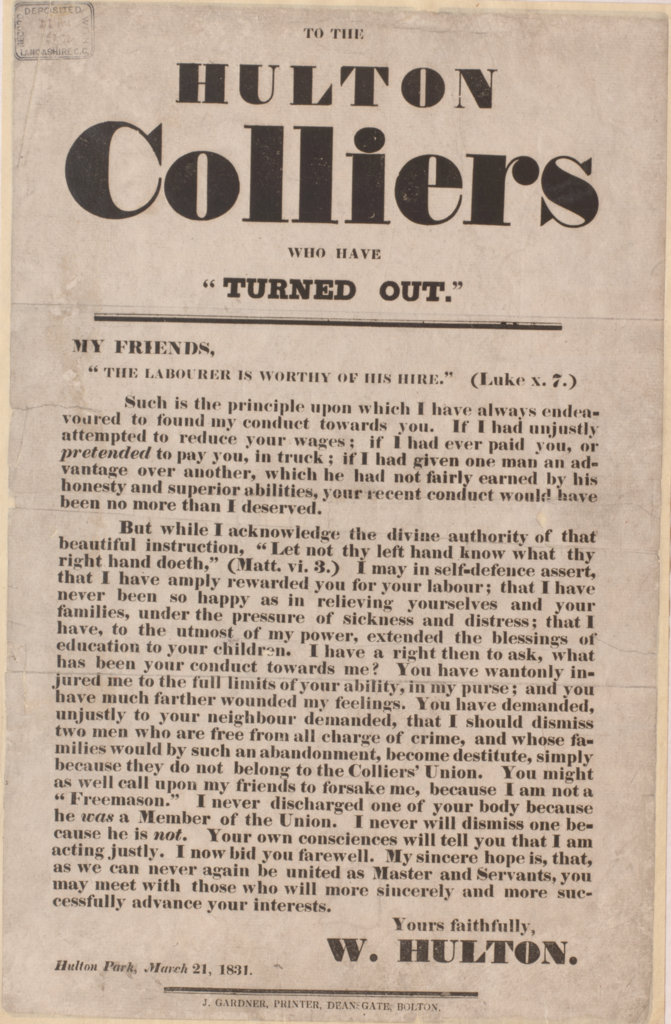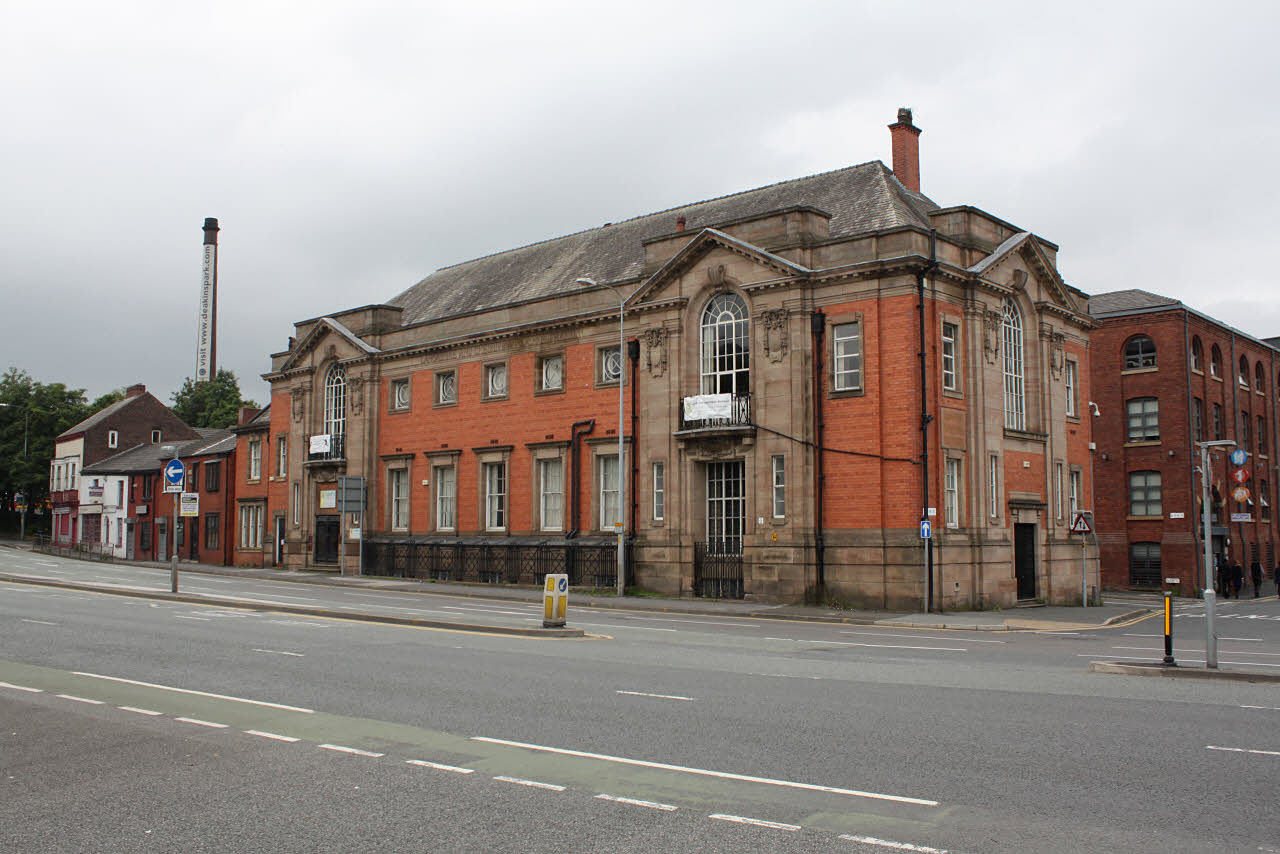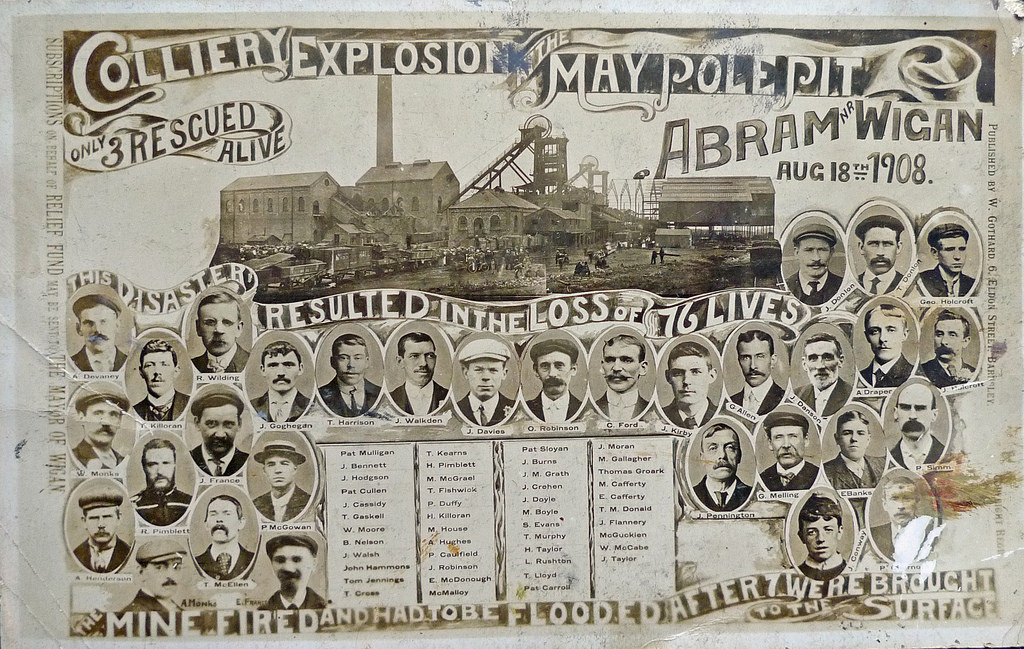|
Hulton Colliery Company
The Hulton Colliery Company was a coal mining company operating on the Lancashire Coalfield from the mid 19th century in Over Hulton and Westhoughton, then in the historic county of Lancashire, England. The company had its origins in small coal mines on the northern part of the Hulton Park estate in 1571 owned by the Hultons who had held the estate from medieval times. Background In the early 19th century the mines were owned by William Hulton who was High Sheriff of Lancashire in 1811 and in 1812 sentenced four men, including a 12-year-old boy, to be executed for their part in a Luddite attack on Westhoughton Mill. His orders led to the Peterloo Massacre in 1819. In 1843 Hulton paid his colliers the poorest wages in Lancashire. He remained opposed to permitting the right to free assembly and was vehemently opposed to miners congregating with the object of forming a union. Hulton's pits thrived and in the 1820s were connected to the Bolton and Leigh Railway. By 1840 there w ... [...More Info...] [...Related Items...] OR: [Wikipedia] [Google] [Baidu] |
Coal Mining
Coal mining is the process of extracting coal from the ground. Coal is valued for its energy content and since the 1880s has been widely used to generate electricity. Steel and cement industries use coal as a fuel for extraction of iron from iron ore and for cement production. In the United Kingdom and South Africa, a coal mine and its structures are a colliery, a coal mine is called a 'pit', and the above-ground structures are a 'pit head'. In Australia, "colliery" generally refers to an underground coal mine. Coal mining has had many developments in recent years, from the early days of men tunneling, digging and manually extracting the coal on carts to large open-cut and longwall mines. Mining at this scale requires the use of draglines, trucks, conveyors, hydraulic jacks and shearers. The coal mining industry has a long history of significant negative environmental impacts on local ecosystems, health impacts on local communities and workers, and contributes heavily to th ... [...More Info...] [...Related Items...] OR: [Wikipedia] [Google] [Baidu] |
Lancashire And Cheshire Miners' Federation
The Lancashire and Cheshire Miners' Federation (LCMF) was a trade union that operated on the Lancashire Coalfield in North West England from 1881 until it became the Lancashire area of the National Union of Mineworkers in 1945. Background Colliery owners fended off unions until well into the 19th century and trade unionism was slow to take a hold on the Lancashire Coalfield. Wages were poor and employers arbitrarily fined men for minor reasons, disallowed wages on false pretexts and victimised perceived radicals. Bonds, a system of hiring that legally tied miners to their job for a year, were used to enforce discipline. Miners protested about poor wages in 1757 when bread prices rose and some marched from Kersal towards Manchester in protest, but were turned back. When trouble flared, the Home Secretary ordered troops to be ready to quell unrest. Long strikes were unsustainable as the miners had no organisation or finances to back them. The first miners' association was the ''Bro ... [...More Info...] [...Related Items...] OR: [Wikipedia] [Google] [Baidu] |
Glossary Of Coal Mining Terminology
This is a partial glossary of coal mining terminology commonly used in the coalfields of the United Kingdom. Some words were in use throughout the coalfields, some are historic and some are local to the different British coalfields. A Adit :An adit is an underground level or tunnel to the surface for access or drainage purposes. Afterdamp :Afterdamp is a mixture of carbon monoxide and chokedamp which replaces atmospheric air after an explosion. Agent :The agent was the senior colliery manager: the term "viewer", "captain" or "steward" also appeared in older regional terminology. Where the mine owner provided the capital and sank the shafts, the agent organised the development of the colliery, determined mining methods, advised the owner on the mine's commercial management and labour policy, and in later years was generally a trained mining engineer. In the management hierarchy the agent was superior to the colliery manager and under-manager, who had day to day operational resp ... [...More Info...] [...Related Items...] OR: [Wikipedia] [Google] [Baidu] |
List Of Mining Disasters In Lancashire
This is a list of mining accidents in the historic county of Lancashire at which five or more people were killed. Mining deaths have occurred wherever coal has been mined across the Lancashire Coalfield. The earliest deaths were recorded in parish registers. Ffrancis Taylior was buried at the Collegiate Church in Manchester after a fall in the "coale pitte" in 1622 and in 1661 or 1662, Thomas Hilton was "slain" at Bradford coal pit as was Thos Greene in 1664. Coal pit related deaths appear in the registers of Wigan Parish Church from the 1670s. In 1779 three "Poor Coaliers" were reported as being injured when the roof collapsed in a coal pit at Alkrington so that "their lives were dispared of..." When the coal industry developed rapidly in the 19th century, labour and life were cheap. Men, women and children perished in explosions, roof falls, floods and haulage accidents. The Lancashire Coalfield, the seventh largest producer of coal in the 1870s, often had the highest acciden ... [...More Info...] [...Related Items...] OR: [Wikipedia] [Google] [Baidu] |
Atherton, Greater Manchester
Atherton () is a town in Greater Manchester, England and historically a part of Lancashire. The town, including Hindsford, Howe Bridge and Hag Fold, is south of Bolton, east of Wigan, and northwest of Manchester. From the 17th century, for about 300 years, Atherton was known as Chowbent, which was frequently shortened to Bent, the town's old nickname. During the Industrial Revolution, the town was a key part of the Manchester Coalfield. Atherton was associated with coal mining and nail manufacture from the 14th century, encouraged by outcropping coal seams. At the beginning of the 20th century, the town was described as "the centre of a district of collieries, cotton mills and iron-works, which cover the surface of the country with their inartistic buildings and surroundings, and are linked together by the equally unlovely dwellings of the people". Atherton's last deep coal mine closed in 1966, and the last cotton mill closed in 1999. Today the town is the third-largest ret ... [...More Info...] [...Related Items...] OR: [Wikipedia] [Google] [Baidu] |
Shaft Mining
Shaft mining or shaft sinking is the action of excavating a mine shaft from the top down, where there is initially no access to the bottom. Shaft (civil engineering), Shallow shafts, typically sunk for civil engineering projects, differ greatly in execution method from deep shafts, typically sunk for mining projects. Shaft sinking is one of the most difficult of all mine development methods: restricted space, gravity, groundwater and specialized procedures make the task quite formidable. Shafts may be sunk by conventional drill and blast or mechanised means. Historically, mine shaft sinking has been among the most dangerous of all the mining occupations and the preserve of mining contractors called sinker (mining), sinkers. Today shaft sinking contractors are concentrated in Canada, Germany, China and South Africa. The modern shaft sinking industry is gradually shifting further towards greater mechanisation. Recent innovations in the form of full-face shaft boring (akin to a v ... [...More Info...] [...Related Items...] OR: [Wikipedia] [Google] [Baidu] |
Mining Rights
Mineral rights are property rights to exploit an area for the minerals it harbors. Mineral rights can be separate from property ownership (see Split estate). Mineral rights can refer to sedentary minerals that do not move below the Earth's surface or fluid minerals such as oil or natural gas. There are three major types of mineral property; unified estate, severed or split estate, and fractional ownership of minerals. Mineral estate Owning mineral rights (often referred to as a "mineral interest" or a "mineral estate") gives the owner the right to exploit, mine, and/or produce any or all minerals they own. Minerals can refer to oil, gas, coal, metal ores, stones, sands, or salts. An owner of mineral rights may sell, lease, or donate those minerals to any person or company as they see fit. Mineral interests can be owned by private landowners, private companies, or federal, state or local governments. Sorting these rights are a large part of mineral exploration. A brief outline ... [...More Info...] [...Related Items...] OR: [Wikipedia] [Google] [Baidu] |
Brickworks
A brickworks, also known as a brick factory, is a factory for the manufacturing of bricks, from clay or shale. Usually a brickworks is located on a clay bedrock (the most common material from which bricks are made), often with a quarry for clay on site. In earlier times bricks were made at brickfields, which would be returned to agricultural use after the clay layer was exhausted. Equipment Most brickworks have some or all of the following: *A kiln, for firing, or 'burning' the bricks. *Drying yard or shed, for drying bricks before firing. *A building or buildings for manufacturing the bricks. *A quarry for clay. *A pugmill or clay preparation plant (see below). Brick making Bricks were originally made by hand, and that practice continues in developing countries and with a few specialty suppliers. Large industrial brickworks supply clay from a quarry, moving it by conveyor belt or truck/lorry to the main factory, although it may be stockpiled outside before entering the mac ... [...More Info...] [...Related Items...] OR: [Wikipedia] [Google] [Baidu] |
Partnership
A partnership is an arrangement where parties, known as business partners, agree to cooperate to advance their mutual interests. The partners in a partnership may be individuals, businesses, interest-based organizations, schools, governments or combinations. Organizations may partner to increase the likelihood of each achieving their mission and to amplify their reach. A partnership may result in issuing and holding equity or may be only governed by a contract. History Partnerships have a long history; they were already in use in medieval times in Europe and in the Middle East. According to a 2006 article, the first partnership was implemented in 1383 by Francesco di Marco Datini, a merchant of Prato and Florence. The Covoni company (1336-40) and the Del Buono-Bencivenni company (1336-40) have also been referred to as early partnerships, but they were not formal partnerships. In Europe, the partnerships contributed to the Commercial Revolution which started in the 13th centur ... [...More Info...] [...Related Items...] OR: [Wikipedia] [Google] [Baidu] |
Leigh, Greater Manchester
Leigh is a town in the Metropolitan Borough of Wigan, Greater Manchester, England, on low-lying land northwest of Chat Moss. Within the boundaries of the Historic counties of England, historic county of Lancashire, Leigh was originally the centre of a large ecclesiastical parish covering six vills or townships. When the three townships of Pennington, Greater Manchester, Pennington, Westleigh, Greater Manchester, Westleigh and Bedford, Greater Manchester, Bedford merged in 1875, forming the Leigh Local Board District, Leigh became the official name for the town, although it had been applied to the area of Pennington and Westleigh around the parish church for many centuries. The town became an Urban district (Great Britain and Ireland), urban district in 1894 when part of Atherton was added. In 1899 Leigh became a municipal borough. The first town hall was built on King Street and replaced by the present building in 1907. Originally an agricultural area (noted for dairy farming), ... [...More Info...] [...Related Items...] OR: [Wikipedia] [Google] [Baidu] |
Bolton
Bolton (, locally ) is a large town in Greater Manchester in North West England, formerly a part of Lancashire. A former mill town, Bolton has been a production centre for textiles since Flemish people, Flemish weavers settled in the area in the 14th century, introducing a wool and cotton-weaving tradition. The urbanisation and development of the town largely coincided with the introduction of textile manufacture during the Industrial Revolution. Bolton was a 19th-century boomtown and, at its zenith in 1929, its 216 cotton mills and 26 bleaching and dyeing works made it one of the largest and most productive centres of Spinning (textiles), cotton spinning in the world. The British cotton industry declined sharply after the First World War and, by the 1980s, cotton manufacture had virtually ceased in Bolton. Close to the West Pennine Moors, Bolton is north-west of Manchester and lies between Manchester, Darwen, Blackburn, Chorley, Bury, Greater Manchester, Bury and ... [...More Info...] [...Related Items...] OR: [Wikipedia] [Google] [Baidu] |









